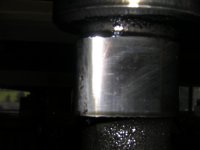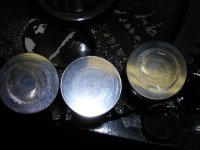You are using an out of date browser. It may not display this or other websites correctly.
You should upgrade or use an alternative browser.
You should upgrade or use an alternative browser.
New vs Regrind cam
- Thread starter Ether Man
- Start date
Muddin_dude06
...
- Joined
- Sep 10, 2007
- Messages
- 2,541
After talking with several cam guys, especially Greg Hogue a regrind is just fine for most all applications. Unless you are wanting a really odd LSA or huge lift the "new" cam would not have any advantage. Whatever cam you buy either have it drilled and tapped for a retainer or buy a cam that has one.
Ether Man
The Racer Formerly Known as ConcreteBlockHead, who
- Joined
- Jun 26, 2006
- Messages
- 414
try to search, there was a heated topic on regrinds. i wont go with one ever again i dont care who makes it.
that sucks. how much power were you making?
explosives87
powder monkey
- Joined
- Aug 14, 2008
- Messages
- 953
I would do a search and look for a thread started by rollin coal. here is the link. Billet cam vs regrind - Competition Diesel.Com - Bringing The BEST Together I would buy a new cam for the simple fact that, you know what the cam as been through and how many miles are it from day one.
Last edited:
YOUNG GUNS15
Im AWESOME!!!!
- Joined
- Sep 24, 2009
- Messages
- 7,346
I read the whole regrind thread back when i was new to this site. That thread scared me away from regrinds. I cant afford to pull my motor apart to replace a faulty camshaft and whatever it took out in the process.
My vote is for a brand new cam, even if it is more exspencive than a regrind do it. like explosives said, your cam has alot of time on it.
My vote is for a brand new cam, even if it is more exspencive than a regrind do it. like explosives said, your cam has alot of time on it.
Hamilton Cams
ignorant
- Joined
- Jun 28, 2007
- Messages
- 2,639
It has been said many times before. In and of themselves, there is nothing wrong with re-grinds a lot of the larger profile regrinds will end up within .005" of the same size base circle of a "new blank" if a 24v 1998-2002 cam is used to regrind. As long as the reground centerlines are similar to what the factory centerlines were, then there is no problem, at all. The problem arises when people try to grind large lift grinds on centerlines differing from the factory units. When the whole lobe has to move over 5 degrees, a lot of meat has to be taken off of the cam to get the shape correct. This eats up metal on the nose as well as metal on the base circle. Eating up base-circle is of less concern but when you drastically change the shape of the nose of the cam where all of the pressure is, you get relatively soft metal in comparison to factory rockwell numbers. Soft lobes are no good for high rpm and spring pressure. It is a recipe for a failed lobe. 12v cores are the worst to regrind because the lobes are narrow and the centerlines have to be moved. Common rails are not much better. The lobe centers have to be moved a major amount, but at least they are wider to distribute the load of the tappet better. If it were me, I would only run a 1998-2002 regrind for a fairly aggressive cam. Mild grinds with low lift and narrow LSA's will be fine for CR and 12v cams.
The bigger question is why are people spending a lot of money on used/re-worked factory cams, when a new cam is not much more. I don't understand all of the cam guru's not having enough money to just ante up and have their own cams made. Why gamble with re-grinds? In most instances, re-grinds either don't take full advantage of optimum centerlines, or if they do they have very soft lobe noses.
One last thing. If a person couldn't afford to have their own cams made, do you think that they will tell you the whole truth about the dangers of re-grinds if that is all that they can afford to work with? Not a knock on anybody just a general observation on human nature.
Zach
The bigger question is why are people spending a lot of money on used/re-worked factory cams, when a new cam is not much more. I don't understand all of the cam guru's not having enough money to just ante up and have their own cams made. Why gamble with re-grinds? In most instances, re-grinds either don't take full advantage of optimum centerlines, or if they do they have very soft lobe noses.
One last thing. If a person couldn't afford to have their own cams made, do you think that they will tell you the whole truth about the dangers of re-grinds if that is all that they can afford to work with? Not a knock on anybody just a general observation on human nature.
Zach
Last edited:
jkretzer
MegaCrank
- Joined
- Jul 9, 2006
- Messages
- 1,444
i am not sure of who did the actual regrind on the cam, i just know who did it. it was taken care of very well, but the sad thing is this was a brand new motor with less then 2k miles and i had to pull the cam. i was only pushing around 400hp with that setup, didnt even have time to dyno it before i had to pull the cam. i do know that cam was violent and even though the one i was given was said to be a very close profile there was a huge difference in spoolup.
try to search, there was a heated topic on regrinds. i wont go with one ever again i dont care who makes it.
Neither will I!
Hamilton Cams
ignorant
- Joined
- Jun 28, 2007
- Messages
- 2,639
Not all regrinds will have failures, just like not all new cams will be failure free. However, re-grinds will have a higher failure rate than new blanks. This is a basic fact. The larger the regrind, the softer the core, and the higher the chance for lobe failure.
Ether man, to get back on topic. You can make that power on a stock cam. If you just want to broaden the hp/tq curve and take advantage of better spool and lower smoke a small "towing" cam will do great for you. Look for a 170-177@.050 intake3 with around .250-.260 lift and an exhaust with .290-.320 and around 206- 212 @.050" Get all of this cut around a 105-107 LSA and you should have very little cut off of your cam and will have the best chances for longevity.
Ether man, to get back on topic. You can make that power on a stock cam. If you just want to broaden the hp/tq curve and take advantage of better spool and lower smoke a small "towing" cam will do great for you. Look for a 170-177@.050 intake3 with around .250-.260 lift and an exhaust with .290-.320 and around 206- 212 @.050" Get all of this cut around a 105-107 LSA and you should have very little cut off of your cam and will have the best chances for longevity.
Last edited:


